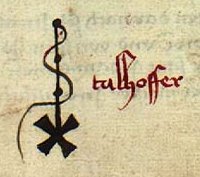
Hans Talhoffer : "Alte Armatur und Ringkunst", 1459
(1) Notes on the Talhoffer Manuscript |
| A depiction of what may be Talhoffer's signature and sign. |
The manuscript contains 150 double-sided pages, or 300 pages of illustrations and text. When navigating the manuscript, recto and verso means the front side and the back side of a plate/leaf. The recto will always be the right "page" of two. To navigate forward or backwards through the manuscript is self-evident, however, do use the drop boxes above and below the "Previous" and "Next" buttons, which allows you to jump up to a maximum of 20 pages forwards or 20 pages back.
Michael Lacy, Ph.D. "Talhoffer's Fechtbüchs: an Introduction". November 19, 1999
Note: Occasionally, the Library's server will fail, and you will receive the following error "Oracle Application Server An Internal error occured in processing the request Please refer to the logs for more information". Please contact at the manuscripts department to notify him of the problem or try the site again at a later time. Their server appears to have some difficulties occasionally.
About the presentation: Click on the image to retrieve a larger image for closer examination. Click here for details on registering with AEMMA and obtaining your Online Library electronic card.
The breakdown of the manuscript is the following (All Talhoffer images on this page, courtesy of The Royal Library, Copenhagen):
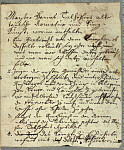 |
1.0 Text (1 recto - 10 verso) There is no known English translation of the prologue available for this manuscript directly, however, a French translation of this manuscript was created by Gustave Hergsell entitled "LIVRE D'ESCRIME DE TALHOFFER DE L'AN 1459" (code d'ambras). This was published in Prague in 1901. The prologue is primarily Liechtenauer's verse for the 17 primary techniques of the longsword, even though the longsword is not the manuscipt's primary focus. Sources for copies of this manuscript can be found by clicking on "Manuscript Sources" button at the bottom of your screen. The Library has digitized not only the text and illustrations, but also the front and back leather covers of the manuscript. The text includes the first 20 pairs of leaves, or, the first illustration appears on 11 recto (enter page 24). You can get to the first illustration from the home page of this manuscript and clicking on 11 recto (enter page page 24) in the screen's bottom left corner. |
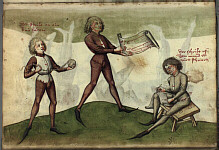 |
2.0 Of Machines and Devices of War (11 recto - 48 verso) (enter "25" under "Page" bottom left of the Library's display). These illustrations depict preparations and devices of war, that include an illustration of an individual receiving a tattoo on his back? (11 verso) (enter page page 26), an individual with a cross-bow firing upon wolves attacking a cow (12 recto (enter page page 27), an interesting illustration of an individual wearing the platform shoes of the day or "pattens" (13 verso) (enter page page 30),  (enter page page 34) implements of discipline/punishment (14 verso) (enter page page 32), troop carrier (15 verso) (enter page page 34), and catapults (16 verso) enter page 36). (enter page page 34) implements of discipline/punishment (14 verso) (enter page page 32), troop carrier (15 verso) (enter page page 34), and catapults (16 verso) enter page 36).Other devices include troops carriers with huge lids on hinges attached with large claw like implements in the edges that can be dropped across a moat, or dropped against a defence wall whereby the hooks penetrate the substrate and prevent the troops carrier from rolling backwards (17 verso) (enter page page 37) (see miniature on the right). Other variations in the manuscript of this carrier includes a lid fitted with a huge spike, which appears to provide a solid anchor point into the ground if the device was used to span a moat (19 recto) (enter page page 40). Another notable device, which appears to be a mobile covered path on wheels (20 verso) (enter page page 44) will protect the troops, presumably from an onslaught of arrows as they make there way to the end of the covered path into their target. Other fascinating devices include a variety of underwater breathing devices (45 recto) (enter page page 90) and giant "trebuchets" or sling-shots. |
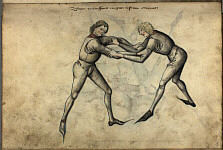 |
3.0 Ringen (Wrestling) (49 recto - 60 verso) (enter "101" under "Page" bottom left of the Library's display). The wrestling illustrations appear very close to the illustrations included in Talhoffer's manuscript of 1467. Most of the grappling and throws are included in the 1467 manuscript, except for the "thumbs up the nose" on 59 verso (enter page page 122) which does not appear in the 1467 manuscript. |
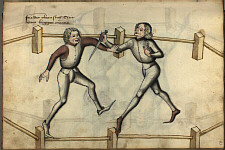 |
4.0 Degen (Dolch) (Dagger) (61 recto - 71 recto) (enter "125" under "Page" bottom left of the Library's display). Classic Talhoffer dagger illustrations, that can be mapped directly to the 1467 manuscript. For example, 64 verso (enter page page 132) depicts "the upper shield against the stab" or "Der obere Schild" which is very similar to tafel 171 in the 1467 manuscript. Other comparisons can be extended to 66 recto (enter page page 134) which depicts one's thrusts over towards the opponent, and the individual on the receiving end breaks with the left arm and seizes him with the dagger between the legs and draws him in and throws him away from himself. |
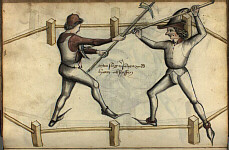 |
5.0 Streitaxt (Pole-axe) (71 verso - 74 verso) (enter "147" under "Page" bottom left of the Library's display). The pole-axe illustrations are very similar to what is included in the manuscript of 1467. However, on 73 verso & 74 verso (enter page page 150), there is an interesting illustration of a black individual on the right wielding a pole-axe. |
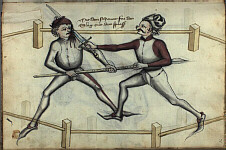 |
6.0 Spear and Sword, Knife, Pike (75 recto - 79 verso) (enter "152" under "Page" bottom left of the Library's display). The spear does not appear in the 1467 manuscript, except for the section that presents the fight in the lists, that includes the spear as one of the weapons deployed. In the page 76 verso (enter page page 152), a graphic illustration depicting the cut to the neck essentially be-heading the opponent with the sword. The opponent was armed with a pike. An interesting form of distraction illustrated in the page 77 recto (enter page page 156) shows one who tossed a hat onto the face of his opponent and then threw his dagger into the chest of the same opponent. This same opponent was armed with a spear. Page 79 recto (enter page page 160) illustrates an individual armed with a cudgel like weapon, fighting against one armed with a longsword. |
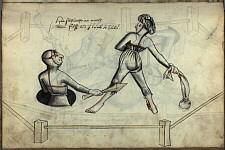 |
7.0 Kämpfe zwischen Mann und Frau (Fight between Man and Woman) (80 recto - 84 recto) (enter "156" under "Page" bottom left of the Library's display). This series of bizarre illustrations depict a man positioned in a hole in the ground, armed with a edged club and engaged with a woman, who is standing and armed with what appears to be a rock in a sock. She will sling the sock, and strike the man, while the man defends himself with this club. |
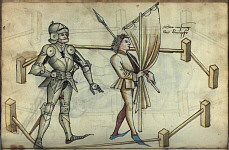 |
8.0 Kämpfe in den Schranken mit Spiess und Schwert in voller Rüstung (Fight in the Lists with Spear and Sword in Full Armor) (84 verso - 87 recto) (enter "172" under "Page" bottom left of the Library's display). This series of illustrations of an armoured judicial duel almost map one-to-one with Talhoffer's 1467 manuscript, down to throwing the spear in the initial portion of the engagement. The armoured judicial duel was typically held between nobles, fought in armour with the knightly weapons that include the spear, longsword and dagger, usually to the death. Essentially, the duel was a private affair and the role of the judge was only to ensure that the duel was conducted according to the formalities of the period. If a noble had to undergo a trial-by-combat to settle the issue of whose case was right or to provide evidence in support of the individual, the challenger had to wear the same clothing and armour as depicted. Not all trials were fought to the death. This was necessary only when a major offenense like murder, treason, heresy etc. was put to court. In the case of a minor offense, the trial would be stopped by the judge when one of the combatants was exhausted, wounded or perceived as being clearly overwhelmed. In this case, the judge could stop the fight and ask the parties if they'd like to consider the issue settled and the point being proven. If the parties agreed, the fight would stop, if not, they would continue, but again not necessarily to the death. |
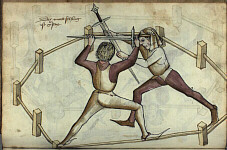 |
9.0 Langes Schwert (The Long Sword) (87 verso - 94 recto) (enter "179" under "Page" bottom left of the Library's display). This fascinating series of illustrations demonstrates similar techniques, including half-sword techniques that are common in the 1467 manuscript. An interesting illustration is on folio 93 verso (enter page page 190), whereby, the individual has killed his opponent and is seen kneeling and praying for his death, and the dead individual has a small horned creature approaching the body. The final image (94 recto) (enter page page 190) of this series illustrates a pair of male individuals, lifting the body in preparation to position it into a wooden box with long carrying poles. |
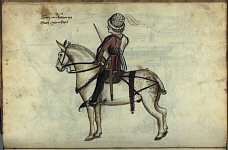 |
10.0 Schwertkämpfe zu Ross (Sword Fight on Horse Back) (94 verso - 97 recto) (enter "192" under "Page" bottom left of the Library's display). A collection of beautiful illustrations depicting mounted techniques, that appear more of a series of poses rather than a series of movements. However, the last illustration does depict an engagement between a pair of mounted combatants. |
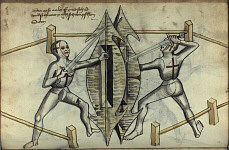 |
11.0 Gekehlte und Hackenschilde (Throated and Hewing Shield) (97 verso - 103 recto, 110 verso - 117 recto) (enter "198" under "Page" bottom left of the Library's display). A fascinating series of illustrations that depict the bizarre hewing shields or hackenschilde. The tightly fitting garments were the compulsory gear for the trial-by-combat or kampfordal, which was a engagement than the judicial duel. Until page 101 verso, the combatants were equiped with a club. After this page, the combatants are now armed with a sword and the hewing shield. The last part of this series includes a number of illustrations that depicts a variety of shapes the shield, perhaps as a specifications page for the reader (104 recto) (enter page page 210). The images include illustrations on the training clothing (107 recto) (enter page page 216) worn when engaged with the hewing shield. |
 |
12.0 Weapons of War (104 recto - 110 recto) (enter "210" under "Page" bottom left of the Library's display). A collection of illustrations that depict numerous variations of the hewing shields (104 recto - 106 recto), clubs (106 verso), the "proper" attire for engagement with the hewing shield (107 recto) (enter page page 216), longswords (107 verso (enter page page 218) - 108 recto), daggers (108 verso) (enter page page 220) and pole-axe (109 recto (enter page page 222) - 110 recto). |
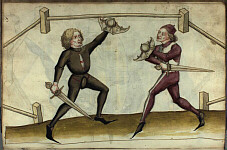 |
13.0 Messer und kleiner Schild (bouclier) (Sword and small Shield (buckler)) (117 verso - 123 recto) (enter "238" under "Page" bottom left of the Library's display). A "Talhoffer" classic series of illustrations depicting sword and shield forms. An interesting image is an individual fending off 2 adversaries (119 recto) (enter page page 240) which is reminescent of tafel 240 in Talhoffer's 1467 publication. Some illustrations depicting the back-sword and buckler on 119 verso. The sword & buckler illustrations do appear to have some commonality with the illustrations of the I.33 manuscript. |
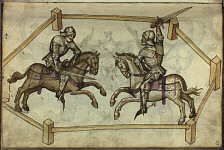 |
14.0 Schwertkämpfe zu Ross (Sword Fight on Horse Back) (124 recto - 130 verso) (enter "251" under "Page" bottom left of the Library's display). These illustrations depict primarily sword combat on horseback, however, there are a number of images that depict mounted combat with lance/spear and lance & cross-bow (130 recto) (enter page page 262). A classic jousting illustration on 130 verso (enter page page 262) depicts a broken lance and the rider beginning to fall off the horse backwards from the thrust of the lance. |
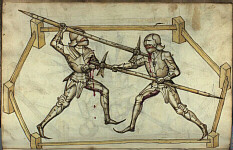 |
15.0 Streitaxt (Pole-axe) (131 recto - 137 verso) (enter "267" under "Page" bottom left of the Library's display). These illustrations provide a unique view with clarity on the arms and armour of pole-weapons combat. Details that are rarely seen in early historical illustrations of armour from various angles of presentation, down to the straps securing the cuisses to the upper legs. The illustrations also reveals the favouritism to "ringen" form of engagement, even when engaged with pole-axe as the illustration on 136 recto and 137 verso enter page 270) indicates. |
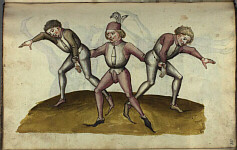 |
16.0 Ringen (Wrestling) (138 recto - 139 verso) (enter "279" under "Page" bottom left of the Library's display). Classic grips and throws are detailed in these illustrations, including an interesting illustration (139 recto) (enter page page 280) whereby an individual while standing is bounded by the wrists and ankles, and the individual next to him is preparing to cut a leather belt in half. |
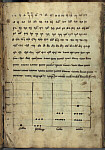 |
17.0 Text (150 verso/s.1 - Back Binding) (enter "284" under "Page" bottom left of the Library's display). The last textual portion of the manuscript are illustrated here. An interesting view of the front (enter page page 1) and back covers/bindings (enter page page 305) of the manuscript are also presented. |
Digital Facsimiles of Copenhagen Manuscripts
Part 1: Middle Ages and Renaissance
Old Royal Collection
Gl. kgl. Saml. 79 2s, "The Mirror of Human Salvation". Parchment, 99 ff. Germany c. 1430
Gl. kgl. Saml. 80 2s, "The Mirror of Human Salvation". Parchment; 54ff. Germany 1400-50
Gl. kgl. Saml. 1606 4s, "The Kristina Psalter". Parchment; 174 ff. Paris c. 1230
Gl. kgl. Saml. 1607 4s, Prayer Book. Parchment, 154 ff. France 15th century
Gl. kgl. Saml. 1610 4s, Book of hours in Latin. Parchment, 76 ff. France 1475-1500
Gl. kgl. Saml. 1612 4s, Book of Hours. Parchment; 44 ff. France, 16th century
Gl. kgl. Saml. 1633 4s, Bestiarius. Parchment, 77 ff. England, 15th century
Gl. kgl. Saml. 3453 8s, Manual from Notmark. Parchment; 88 ff. 14th century
Gl. kgl. Saml. 3466 8s, Bestiaire. Parchment, 51 ff. England, c. 1300
Gl. kgl. Saml. 3484 8s, Arzneibuch. Paper, 182 ff. Germany, 1468
New Royal Collection
Ny kgl. Saml. 50 h 8s, Prayer Book. Parchment, 46 ff. Flanders (?), 1500-1525
The Collection of Thott
Thott 143 2s, "The Copenhagen Psalter" (ff. 1 recto - 18 recto). Parchment; 199 ff. England 1175-1200
Thott 290 2s, Art of War. Paper; 150 ff. Bayern 1459
Thott 21 4s, The four gospels in Latin. Parchment; 158ff. Lund, c. 1150
Thott 517 4s, Legends. Parchment; 38ff. England, c. 1370
Thott 547 4s, Book of Hours. Parchment; 66ff. England, c. 1370
Thott 291 8s, Chansons d'Amour, Parchment, 47 ff. France, 15th century
E donatione variorum
E don var 140 4s, Codex Esromensis. Parchment, 215 ff. Esrum 1496-1497